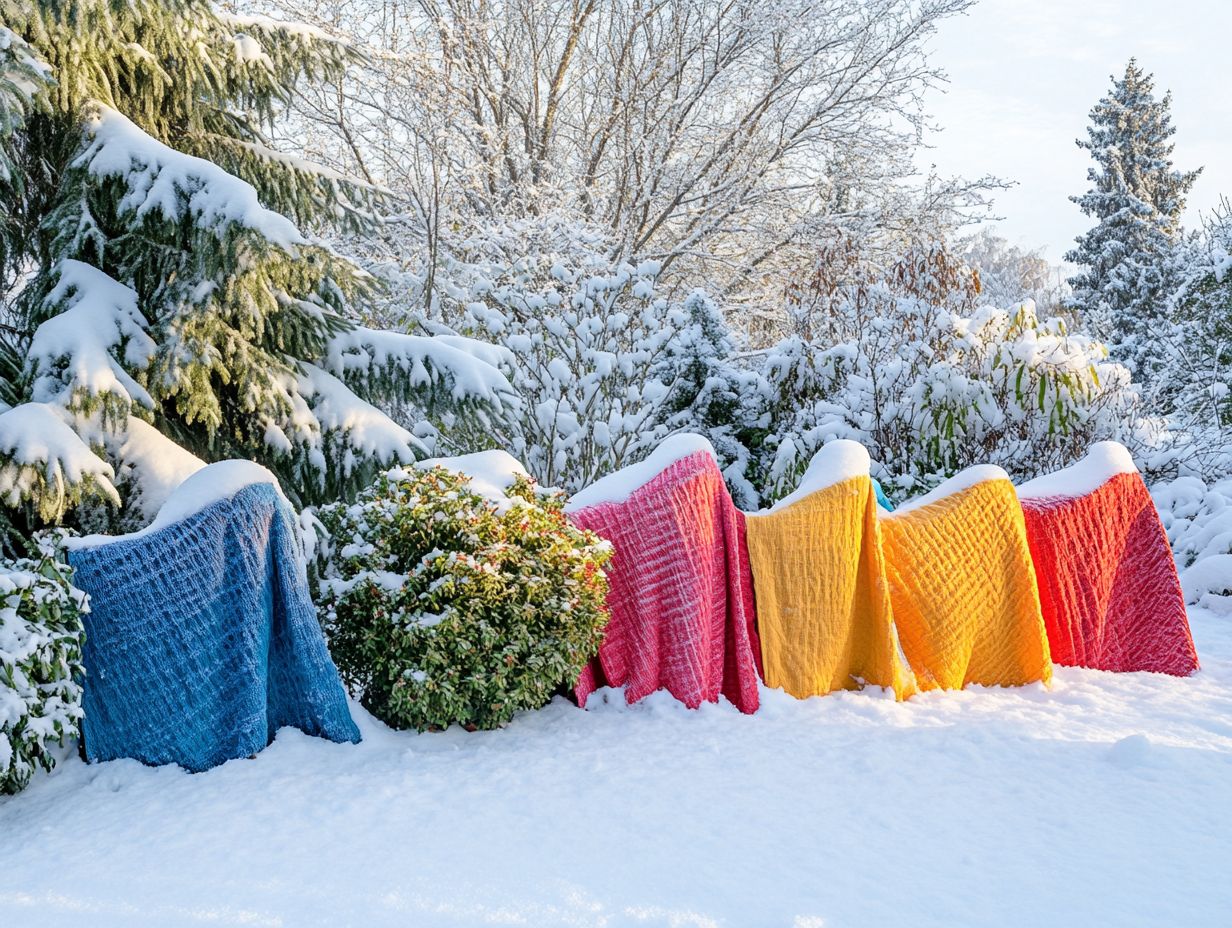Thermal Blankets: Essential Tools for Winter Gardens
When winter arrives, nurturing a flourishing garden can seem like an uphill struggle.
Thermal blankets become your garden’s steadfast allies during these chilly months. These important tools shield your plants and soil from biting frost while boosting energy efficiency in your winter landscape.
Get ready to explore the various types of thermal blankets at your disposal, learn how to use them effectively, and identify crucial factors to consider when selecting the perfect one for your garden.
Equip yourself with insights that will empower you to keep your winter garden thriving!
Contents
- Key Takeaways:
- Benefits of Using Thermal Blankets in Winter Gardens
- Types of Thermal Blankets
- How to Use Thermal Blankets in Winter Gardens
- Choosing the Right Thermal Blanket for Your Garden
- Frequently Asked Questions
- What are thermal blankets and why are they essential for winter gardens?
- Can I use regular blankets instead of thermal blankets for my winter garden?
- How do I use thermal blankets in my winter garden?
- Do thermal blankets work for all types of plants?
- Are there different types of thermal blankets available?
- Can thermal blankets be reused for multiple winters?
Key Takeaways:

- Thermal blankets provide essential protection for plants and soil in winter gardens by keeping a consistent temperature and preventing frost damage.
- Not only do thermal blankets benefit plants, but they also promote energy efficiency by reducing the need for excessive heating.
- When choosing a thermal blanket for your garden, consider factors such as material, size, and durability to ensure proper use and effectiveness.
What are Thermal Blankets?
Thermal blankets, often called frost blankets, are essential tools for you as a gardener. They provide effective frost protection for your sensitive plants during cold weather. These lightweight, breathable materials act as a shield against frost damage, ensuring your plants stay healthy while still allowing essential air, water, and sunlight to reach them.
By grasping their importance, you can enhance the effectiveness of these insulation fabrics, helping to safeguard your crops against unpredictable climatic conditions.
Among the various options at your disposal, fleece blankets offer that extra layer of warmth, combining softness and lightweight properties ideal for nurturing delicate seedlings. On the other hand, plastic frost blankets stand as a robust barrier against harsh winter winds and moisture loss.
These coverings also help retain soil warmth, significantly reducing evaporation, and promoting vital moisture retention for thriving plants, especially during dry spells.
Both types play a critical role in boosting your plants’ resilience and vigor, ensuring your garden flourishes even when temperatures take a turn for the unexpected.
Benefits of Using Thermal Blankets in Winter Gardens
Utilizing thermal blankets in your winter garden offers a wealth of advantages, especially for those delicate plants that need extra protection from frost and chilly temperatures. By effectively insulating your crops, you can enjoy extended growing seasons and enhanced plant health something that s particularly vital for tropical plants that are susceptible to frost damage.
Embracing this practice not only safeguards your greenery but also elevates your gardening experience.
Protection for Plants and Soil
Protection for your plants and soil is essential during the winter months, and thermal blankets can be your secret weapon against frost damage, especially for those sensitive plants. These covers shield your crops from the biting cold and help maintain soil temperature and moisture levels, ultimately enhancing both flavor and overall plant health.
The insulation provided by thermal blankets significantly reduces temperature fluctuations that can be harmful to delicate foliage and root systems. Choosing the right type of blanket is paramount; for example, fleece blankets offer warmth while allowing air to circulate, making them perfect for tender seedlings. On the other hand, plastic frost blankets provide a more robust barrier against harsh winds and frost for your hardier varieties.
By selecting the ideal blanket tailored to the specific needs of your plants, you can effectively mitigate frost risks and promote healthier growth throughout the chilly months.
Start using thermal blankets today to keep your garden thriving all winter long!
Energy Efficiency

Utilizing thermal blankets can greatly enhance energy efficiency in your winter garden. For more effective strategies, consider these tips for using greenhouses in winter gardening. They reduce the need for extra heating sources while providing optimal insulation for your sensitive plants.
This sustainable approach not only conserves energy but also nurtures a healthier gardening environment.
By effectively trapping warmth and minimizing heat loss, these innovative coverings can lead to significant reductions in your energy costs. They are a wise choice for eco-conscious gardeners like you.
Brands such as Greenhouse Megastore offer a variety of energy-efficient gardening solutions designed to boost plant health while being considerate of our planet’s resources.
Embracing these practices yields immediate savings and promotes long-term sustainability. This ensures that future generations can enjoy the benefits of a flourishing, low-impact garden.
Types of Thermal Blankets
You ll find a range of thermal blankets available, each designed for specific gardening needs. From floating row covers to fleece frost blankets and plastic frost blankets, these insulation fabrics are invaluable.
Typically crafted from breathable materials like polypropylene, their effectiveness and application depend on the sensitive plants you aim to protect. Make the right choice to help your garden flourish, even in less-than-ideal weather conditions.
Reflective and Insulating Materials
Reflective and insulating materials are essential for maximizing the effectiveness of thermal blankets. They provide optimal frost protection for your plants.
Many blankets use materials like aluminized polyethylene film, a type of plastic that reflects heat back toward your plants. This creates a warm microclimate that nurtures growth. Lightweight insulating materials, such as polypropylene, offer excellent thermal retention without sacrificing airflow.
Striking the right balance between insulation and breathability is crucial. This prevents overheating and ensures that moisture the water vapor in the air that can affect plant health doesn’t accumulate and potentially harm delicate foliage.
You’ll find that many popular gardening products incorporate these innovations. They allow you to effortlessly shield your crops from sudden temperature drops while fostering healthy growth through optimal conditions.
How to Use Thermal Blankets in Winter Gardens
Installing and maintaining thermal blankets properly is key to their effectiveness, especially for frost protection and preventing moisture buildup that can jeopardize delicate plants.
By following best practices, you can effectively harness these tools to promote healthy plant growth, even during the coldest months.
Proper Installation and Maintenance

Proper installation and maintenance of frost blankets are essential for maximizing their protective benefits. This ensures that your sensitive plants remain shielded from cold temperatures and frost damage.
Consider factors like air circulation and temperature forecasts to determine the most effective methods for applying these blankets.
- Start by installing the blankets during the late evening or early morning hours when temperatures are mild. This gives your plants a chance to acclimate before the cold hits.
- Securing the blankets is crucial; using stakes or weights prevents potential damage from wind and promotes better coverage. Regularly check for proper air circulation. On sunny days, lift the edge of the blanket slightly to prevent overheating.
- Finally, maintain the blankets by inspecting them for rips or wear. This will ensure they remain effective throughout winter, providing your plants with the protection they need and promoting robust health as spring approaches.
Don t wait protect your plants now! Start using thermal blankets today and see the difference in your garden!
Choosing the Right Thermal Blanket for Your Garden
Choosing the right thermal blanket for your garden requires thoughtful consideration of several factors to ensure best frost protection and maintain plant health.
With a vast array of options available, including top-tier frost blankets crafted from better insulating materials, you must assess your particular needs and the types of plants you are safeguarding. This careful evaluation will enable you to make an informed decision, ensuring your garden thrives even in challenging conditions.
Factors to Consider
When you’re selecting a thermal blanket, there are several critical factors to consider, such as your garden supplies, moisture buildup, and the cold resistance of the plants you want to protect. These elements are essential in determining the most suitable thermal blanket to ensure effective frost protection throughout the winter months.
Understanding the specific needs of your plants is key. This knowledge guides you in choosing the thermal blankets that offer optimal shelter. For example, delicate blooms may require lightweight, breathable materials that allow air to pass through while still providing warmth. On the other hand, hardier plants, like certain perennials, benefit from thicker, insulated covers that effectively trap heat.
Choosing the right blanket not only shields against frost but also minimizes moisture buildup, which can lead to rot or disease. Assess your local climate! This step is crucial for choosing the right blanket. Opting for heavy frost blankets in exposed areas while using lightweight breathable options in sheltered zones can significantly enhance the viability of your garden plants during harsh weather.
Final Thoughts on Thermal Blankets for Winter Gardens
Thermal blankets are essential allies for your winter garden, providing vital frost protection that keeps sensitive plants thriving. By embracing sustainable gardening practices and choosing the right thermal blankets, you can also benefit from the top 10 must-have tools for winter gardening to extend your growing season and savor the rewards of bountiful crops and enhanced flavor.
These innovative blankets protect your plants from harsh weather while creating a cozy environment that promotes healthy plant growth. It s important for you to explore the various types of thermal blankets available, such as fleece frost blankets, plastic frost blankets, and floating row covers from lightweight breathable materials to more durable strong plastic materials, ensuring you meet your specific gardening needs effectively.
By making informed choices, you position yourself to adapt your strategies to regional climate conditions, leading to healthier plants and improved yields through effective alternative insulation against cold. Investing in high-quality thermal blankets will yield significant long-term benefits, resulting in lush, sustainable gardens that flourish even in the coldest months.
Frequently Asked Questions

What are thermal blankets and why are they essential for winter gardens?
Thermal blankets are specially designed coverings made from insulating materials such as fleece or plastic. They help to regulate temperature and protect plants from cold temperatures, making them essential for maintaining a healthy winter garden.
Can I use regular blankets instead of thermal blankets for my winter garden?
No. Regular blankets don t provide the necessary insulation or breathability for plants.
How do I use thermal blankets in my winter garden?
Thermal blankets can be placed over plants or pots to provide protection from cold temperatures. It is important to ensure the blankets are securely in place and that there is enough air circulation for the plants.
Do thermal blankets work for all types of plants?
While thermal blankets are beneficial for most plants, they may not be suitable for all types. It is important to research the specific needs of your plants and consult with a gardening expert if you are unsure.
Are there different types of thermal blankets available?
Yes, several types of thermal blankets exist. These include fleece, plastic frost blankets, and breathable materials like burlap.
Each type offers unique benefits and is suited for different plants. For example, tropical plants may require more insulation protection.
Choose the right blanket based on your needs. Consider how long the cold lasts and how hardy your plants are.
Can thermal blankets be reused for multiple winters?
Yes, get ready to reuse your thermal blankets! They can last for many winters as long as they are in good condition.
Store them properly in the off-season to prevent damage. This makes it easy to remove and use them when needed.






